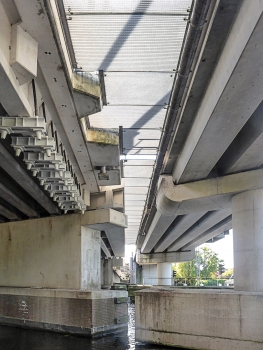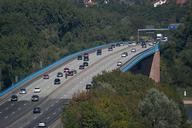Strengthening of the A44 approach bridges near Leiden, The Netherlands
The bridge accommodating the A44 Motorway near the city of Leiden northeast of The Hague is more than 50 years old. Here, two parallel steel bascule bridges with reinforced concrete approach bridges cross the Old Rhine River. Due to a significant increase in traffic volume on this section within the last decades, the Rijkswaterstaat decided to replace the entire asphalt wearing surface, to replace the steel bascule bridges and to strengthen some sections of the approach bridges.
The superstructure of the approach bridges consists of 1.1 m high, T-shaped precast post-tensioned concrete girders. The total deck width is approx. 20.2 m. On the north side, there are five about 22 m long spans with 2×8 girders per span. On the south side, there are four approx. 20 m long spans with 2×6 girders per span. A 20 cm thick top slab was cast in place partly between the 15 cm thick upper flanges of the girders and partly above them. Furthermore, four transverse beams were cast in place to provide sufficient structural integration of the girders.
Cracking in concrete girders and corrosion of post-tensioning anchorages
In various precast concrete girders, diagonal cracking and local corrosion of the post-tensioning anchorages was detected. Furthermore, some girders had been exposed to a fire in the past. After comprehensive investigations into the structure and calculations which were carried out with reduced pre-stressing forces, it was determined that the shear capacity of several girders was insufficient to meet current requirements.
Strengthening solution using post-tensioning stirrups
Therefore, a strengthening solution using so-called "post-tensioning stirrups" was proposed by the consulting engineers. DSI Construction Netherlands produced, supplied, installed and tensioned a total of 439 of those special post-tensioning stirrups that were used near the supports of the 21 girders with reduced bearing capacity. Each post-tensioning stirrup consisted of two vertical bar tendons that were installed vertically along the girders. A total of 878 bar tendons were used.
At the upper side of the girders, a massive anchor plate with two welded couplers was used as a dead-end anchor. At the lower side, a steel beam was used as support for two separate stressing anchors. At each post-tensioning stirrup, two bar tendons were stressed simultaneously with a force of 365 kN per tendon. After stressing, the PE sheathing of the tendons was grouted and protection caps were applied in order to obtain adequate corrosion protection for the tendons.
Work on this complex and challenging project was carried out within a very tight schedule in order to limit traffic obstructions to a minimum.
References
Structure Types
- About this
data sheet - Product-ID
7560 - Published on:
02/01/2018 - Last updated on:
17/11/2021





